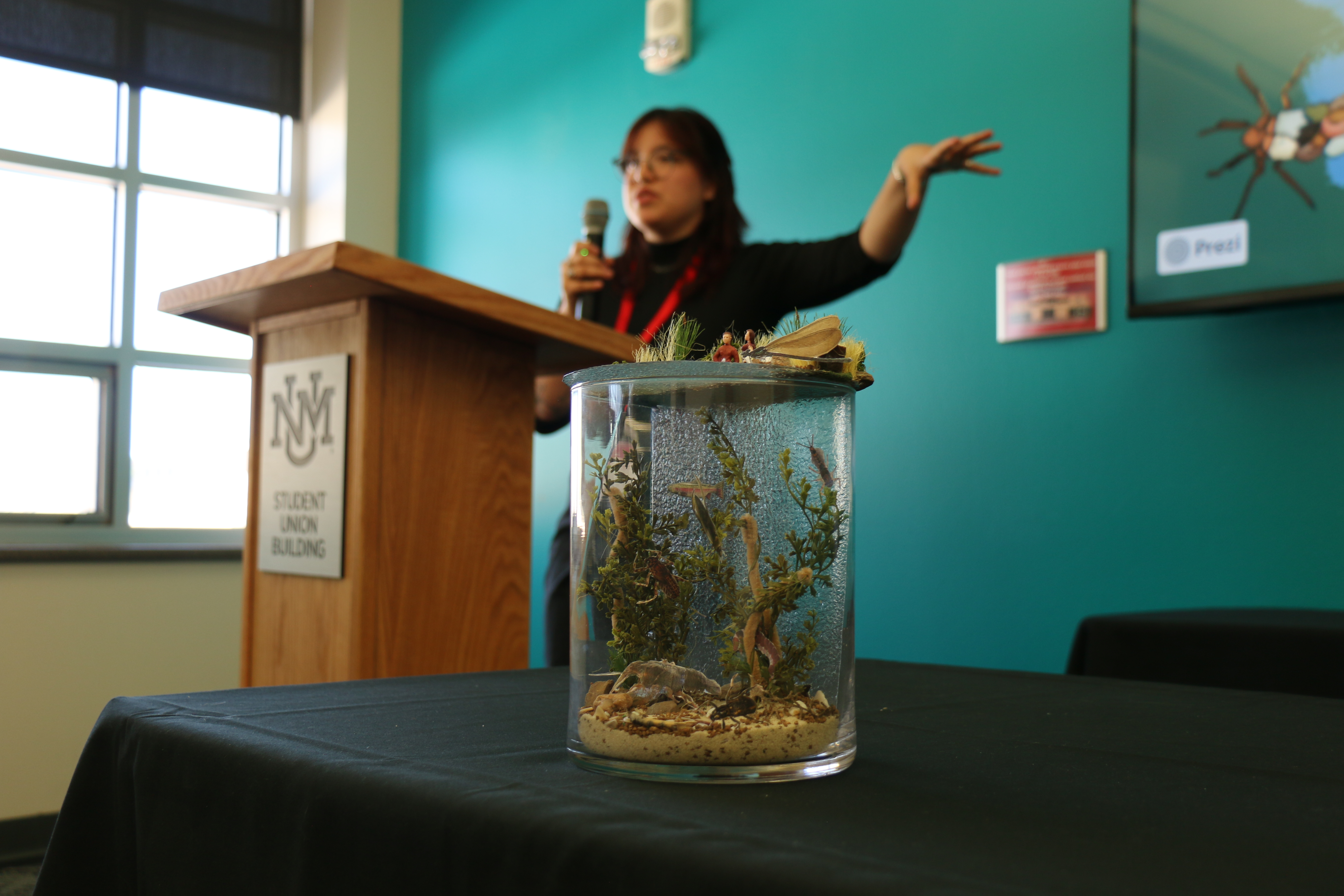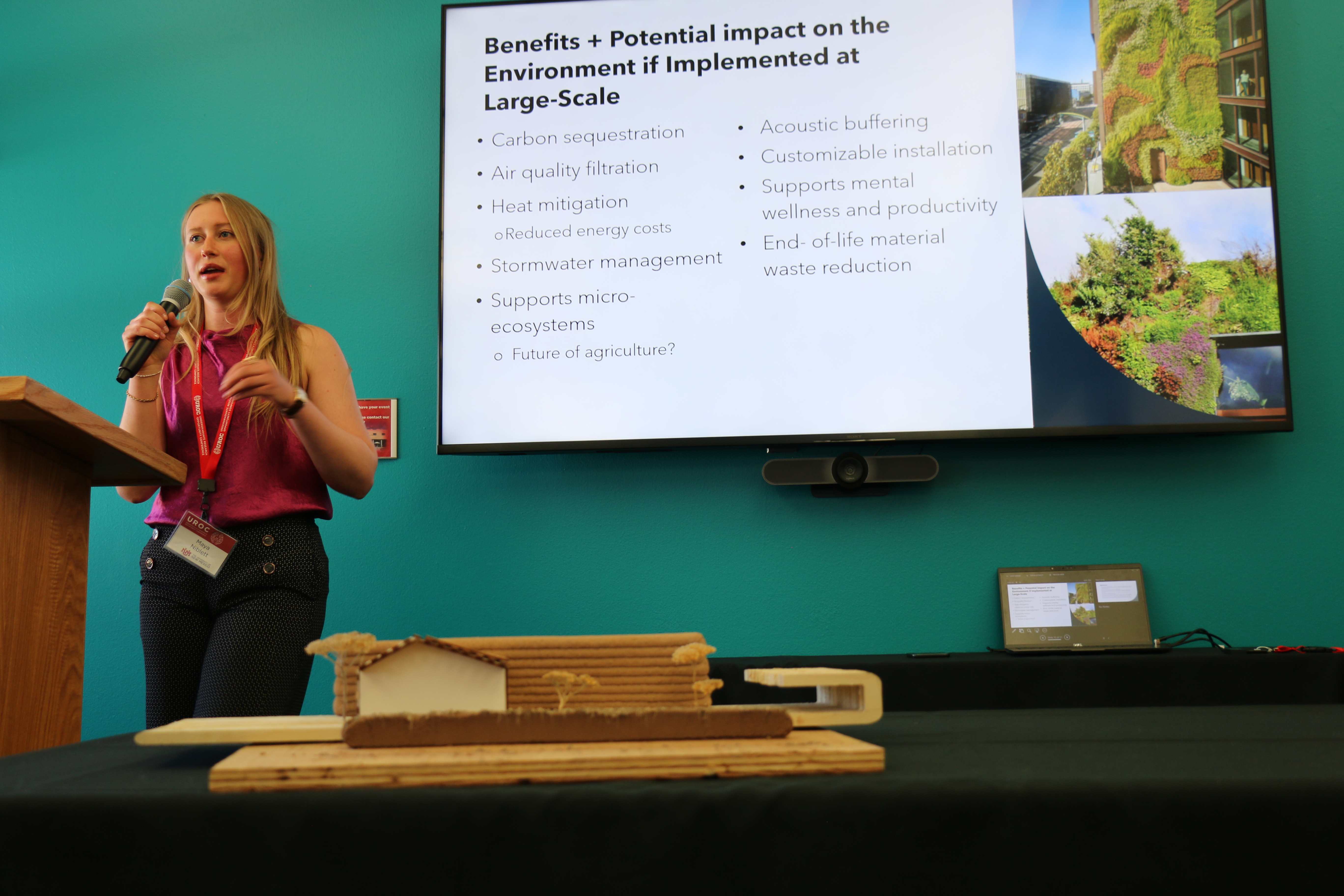Annual Undergraduate Water and Climate Science Communication Fellowship event educates through creativity
April 21, 2025 - by Kim Delker
When a diorama, a living wall made of chia seeds and a video featuring a UNM water plant operator all come together, it can mean only one thing: the annual Undergraduate Water and Climate Science Communication Fellowship presentations, held April 11 at The University of New Mexico.
The event, which began under the UNM Grand Challenges focus area of sustainable water resources, was one of the events in the annual Undergraduate Research Opportunity Conference (UROC), organized by the Undergraduate Research, Arts and Design Network (URAD).

The program pairs undergraduate students with mentors —who can be faculty or other students — to collaborate on a creative project based on the mentor’s research that would be used to explain the water science-related research to a general audience.
The Water Science Communication Fellowship was started in 2022 by Anjali Mulchandani, assistant professor in the Gerald May Department of Civil, Construction and Environmental Engineering, along with Sydney Donohue Jobe, education specialist for the Center for Water and the Environment.
Mulchandani noted that this year, there were five freshmen participating, which she attributes partially to getting the word out to students about the opportunity, and also an increasing awareness about the benefit of undergraduate research.
There were also a record number of projects that involved videos or technology-centric presentations.
“We may be seeing a change in the way a new generation of students is choosing to communicate,” she said. “While in the past, poster presentations were the standard, most of our undergrads are extremely comfortable with technology and multimedia presentations, and that is reflected in the presentations.”
Carly Salazar, a computer science and statistics major, created a website that uses Interferometric Synthetic Aperture Radar (InSAR) to gather satellite data to detect changes in the Estancia Basin ground’s surface elevation, which can be used to identify land subsidence.
There were also presentations that took creativity in a completely different direction, utilizing technology for a very tactile purpose.
Maya Niblett, a pre-professional architecture major, worked with Maryam Hojati, an assistant professor civil, construction and environmental engineering, to create a “green wall” using 3D-printed soil and chia seeds. The research indicates that this approach offers both a low-carbon approach to building materials, as well as an aesthetically pleasing one.
“This is the future of design, the future of architecture,” Niblett said. “Buildings can give back instead of take away.”
Biology major Xavien Artiaga created a diorama to illustrate what happens beneath the surface of a river, such as how macroinvertebrates live and interact with their environment and how their presence can improve the health of a stream.

And Sofia Horn, also a biology major, utilized a traditional form of communicating science (a poster) along with a nontraditional one — a sticker. The sticker said, “Don’t Bust the Crust,” with an illustration of a boot about ready to step on an animated and horrified crust. Her project focused on biocrust and why it is important to an ecosystem.
A new aspect this year is integration with a U.S. Environmental Protection Agency-funded program that Mulchandani began leading last year. The project, called “Educating the Future Workforce on Adapting Water Infrastructure to Climate Change Impacts on the Natural Environment,” is a collaboration between four other universities, with the goal of helping to introduce undergraduates to careers in the water industry. Thanks to this grant, the water science event this year was able to take students on field trips related to the water industry, as well as giving them the experience of attending technical committee meetings and seminars.
Working from the start of this event along with Mulchandani have been Donohue Jobe and Kamryn Zachek, an economics and philosophy major. She began working on the project as a freshman.
It will be the last year for both Donohue Jobe and Zachek. Donohue Jobe will be moving out of state, and Zachek is graduating in May, with plans to pursue law school.
Each participating student receives a stipend to complete their communication project. No research experience is necessary, and students from any discipline are invited to participate.
The students who presented and their project titles were:
- Xavien Artiaga, Biology; minor: Chemistry. Mentor: Rhett Sanders-Spencer. Presentation: “Reading the Water: Using Aquatic Life to Understand Ecosystem Resilience.”
- Jack Barkhurst, Environmental Planning and Design, Film Production; minor: Honors certificate. Mentor: Marisa Repasch. Presentation: “Carbon’s Journey from Arctic Rivers to Atmosphere.”
- Olympia Dawn Breen, Biology, minor in Chemistry. Mentor: Eva Stricker. Presentation: “A Collection of the Effects and Possible Effects of Federal Funding Freezes/Cuts on Agricultural Science and Sustainable Food Production.”
- Micah Cornelio, Construction Engineering/Studio Art (minor). Mentors: Anjali Mulchandani, Sydney Donohue Jobe. Presentation: “Beyond the Pipes: Exploring Waste and Water Careers.”
- Luz De Avila, Mechanical Engineering. Mentors: Carl Abadam and Carmen Atchley. Presentation: “Water Harvesting Efficiency: How Global Warming and Daily Actions Affect our Water Supply.”
- Arisvet Garay, Construction Engineering. Mentor: Jaimie Ritchie. Presentation: “Seasonal Variations in Criteria Pollutants: Trends and Influences.”
- Sofia Horn, Biology, Art Studio. Mentor: Will Bieker. “Resistance of Biological Soil Crust from Drought.”
- Dimitri Kittrell, Civil Engineering. Mentor: Adrianna Fragozo. Presentation: “The Scale of Transportation on Carbon Emissions.”
- Neha Mahato, Biology. Mentor: Tyler Clayshulte. Presentation: “The Changing Dynamics of Harmful Algal Blooms in the Middle Rio Grande.”
- Eliana Merhege, Mechanical Engineering. Mentor: Allyson McGaughey. Presentation: “Refining Water Treatment Methods to Improve Waste Management from the Oil and Gas Industry.”
- Maya Niblett, Pre-professional Architecture; minors: Sustainability and Dance. Mentor: Maryam Hojati. Presentation: “The Living Wall: Carbon Conscious Design.”
- Aiden Parsonese, Mechanical Engineering. Mentors: A.J. Barney and Heather Himmelberger. Presentation: “Wastewater is a Resource.”
- Carly Salazar, Computer Science and Statistics. Mentor: Eric Lindsey. Presentation: “Estancia Basin Land Subsidence Web Application.”
- Christal Valdez, Computer Science, Economics. Mentor: “Heidi Honegger Rogers. Presentation: “Forever Chemicals, Environmental Health and Nurses’ Role in Change.”
The Undergraduate Water and Climate Science Communication Fellowship program is supported by ARID (Accelerating Resilience Innovations in Drylands), the Center for Water and the Environment, the EPA Innovative Water Infrastructure Workforce Development Program, and the Undergraduate Research, Arts and Design Network.
